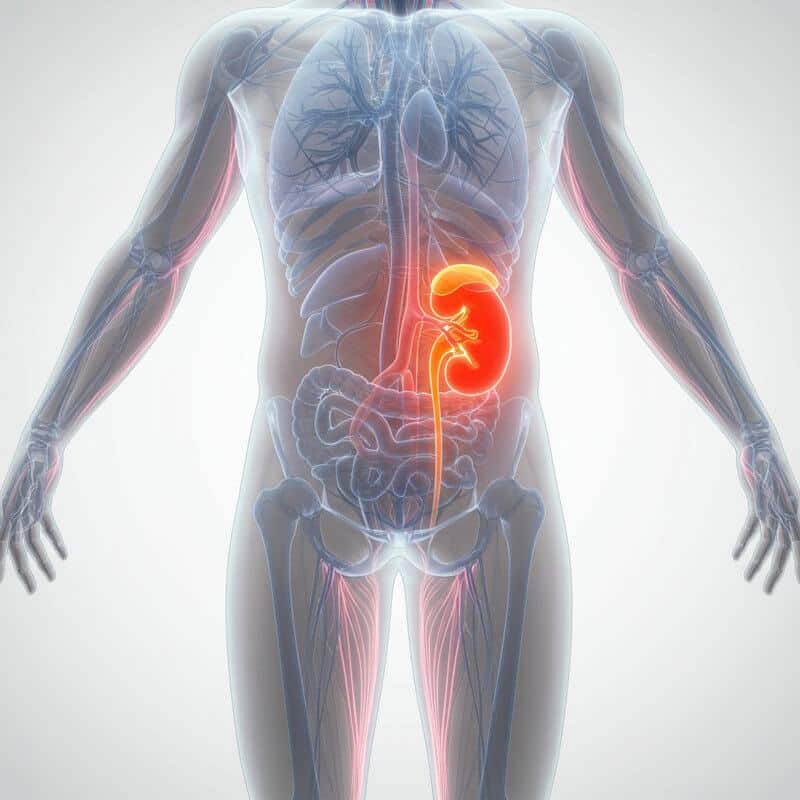The Morning Routine That Can Make or Break Your Glucose Levels
According to the CDC, over 37 million Americans have diabetes, while 96 million more live with prediabetes, often unaware. At the heart of glucose regulation lies the endocrine system—especially the pancreas, which produces insulin to control blood sugar. Yet, early signs of impaired glucose regulation are notoriously subtle, making detection and proactive management challenging. Recent studies underscore the profound impact of daily habits on metabolic health, suggesting that our morning routines may be a critical lever for stabilizing or disrupting blood sugar levels (source).
1. Waking Up at a Consistent Time

Maintaining a consistent wake-up time is crucial for supporting your body’s circadian rhythm, which directly influences glucose metabolism. The circadian clock regulates hormone release, including insulin, and helps synchronize metabolic processes throughout the day. Disruptions to this rhythm—such as waking up at different times—can impair your body’s ability to process glucose efficiently. In fact, research shows that irregular sleep patterns can mimic the metabolic disturbances observed in shift workers, who are at higher risk for insulin resistance and type 2 diabetes (source).
To stabilize your circadian rhythm and optimize glucose control, experts recommend setting a consistent alarm, even on weekends, and establishing a calming bedtime routine. Going to bed and waking up at the same time each day helps anchor your biological clock, improving not only blood sugar regulation but also mood, energy, and overall health. Aim for 7-9 hours of quality sleep nightly, and avoid late-night screen time or caffeine, which can delay sleep onset and disrupt your morning routine. Embracing this simple habit can be a powerful step toward better metabolic health (source).
2. Hydrating First Thing

Overnight, the body naturally loses water through respiration and perspiration, leading to mild dehydration by morning. This state can concentrate blood and transiently elevate glucose levels, as less fluid is available to dilute circulating sugars. Studies have found that chronic dehydration is linked to impaired glucose regulation and reduced insulin sensitivity, increasing the risk for metabolic disorders (source). Proper hydration, on the other hand, supports kidney function, assists in glucose excretion, and helps maintain stable blood sugar throughout the day.
Research published in the journal Diabetes Care highlights that people who drink more water are less likely to develop hyperglycemia and insulin resistance. To prioritize hydration, keep a glass or bottle of water by your bedside and aim to drink at least 16-20 ounces (about 500 ml) soon after waking. If you struggle with plain water, infuse it with lemon or cucumber for added flavor and micronutrients. Avoid caffeinated beverages as your first drink, as they can further dehydrate you. Making morning hydration a ritual is a simple, evidence-based way to support healthy glucose metabolism.
3. Morning Light Exposure

Exposure to natural sunlight in the morning is a key regulator of the body’s circadian rhythm, which in turn influences insulin sensitivity and glucose metabolism. When sunlight enters your eyes soon after waking, it sends powerful signals to your brain’s suprachiasmatic nucleus, helping to synchronize your internal clock and improve metabolic responses throughout the day. Multiple studies, including those summarized by the National Institutes of Health, indicate that robust circadian alignment through morning light exposure can enhance insulin effectiveness and reduce the risk of metabolic disease.
Indoor routines, especially those spent under artificial lighting, may fail to provide the intensity or spectrum of light required for optimal circadian signaling. In contrast, stepping outside—even on a cloudy day—delivers far more biological benefit. Experts recommend spending at least 10 minutes outdoors in the morning light, ideally before 9 a.m., to maximize these effects (source). Whether you take a brisk walk, sip coffee on the porch, or tend to a garden, this simple habit can boost mood, sharpen alertness, and directly support your body’s ability to manage glucose efficiently throughout the day.
4. Avoiding High-Sugar Breakfasts

The first meal of the day plays a pivotal role in setting the tone for your blood glucose levels. High-sugar breakfasts—such as pastries, sweet cereals, or even flavored yogurts—cause rapid spikes in blood sugar, followed by sharp crashes that can lead to fatigue, cravings, and impaired focus. A study published in Nutrients found that individuals who consumed high-glycemic breakfasts exhibited higher post-meal glucose readings and greater insulin demand, compared to those who ate protein-rich options like eggs or Greek yogurt.
In contrast, breakfasts centered on protein and healthy fats—such as eggs, cottage cheese, or nut butters—lead to a more gradual increase in blood sugar and promote sustained energy. These meals also enhance satiety, reducing the likelihood of overeating later in the day. To make informed choices, experts recommend checking nutrition labels for added sugars and opting for whole foods whenever possible. According to the CDC, limiting added sugars at breakfast is a simple but effective strategy to maintain healthy glucose levels and support overall metabolic well-being.
5. Including Protein in Breakfast
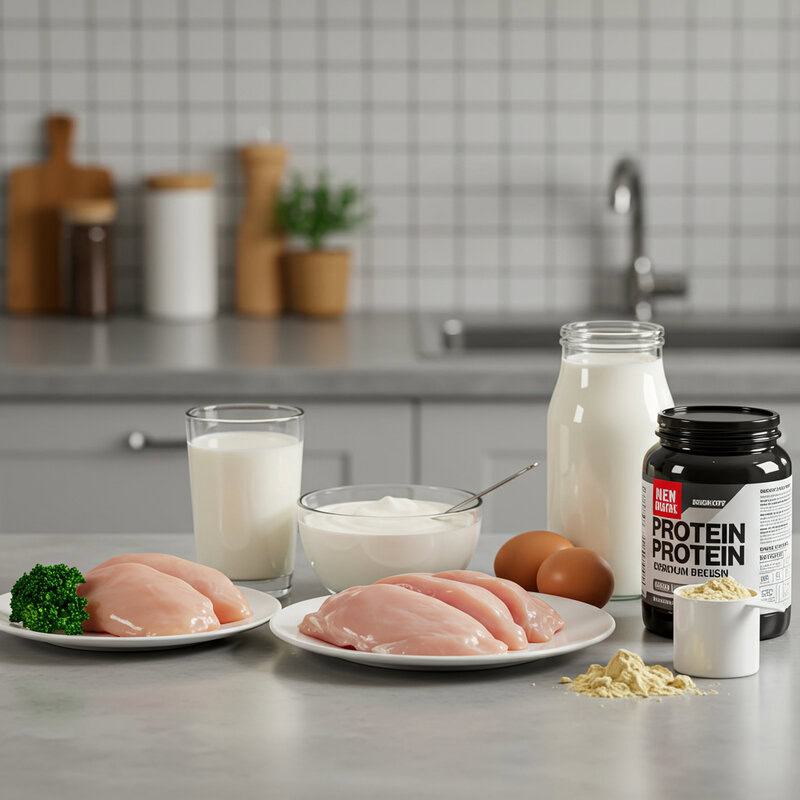
Incorporating a source of protein into your morning meal is a proven way to moderate post-meal glucose spikes and support metabolic health. Protein slows the absorption of carbohydrates, leading to a more gradual and controlled rise in blood sugar after eating. Research, such as a study published in Nutrients, demonstrates that higher protein intake at breakfast reduces both the magnitude and duration of glucose elevations compared to carbohydrate-heavy meals.
Additionally, protein-rich foods stimulate the release of satiety hormones like peptide YY and GLP-1, which not only help manage appetite but also contribute to improved insulin sensitivity. This hormonal response encourages you to feel fuller for longer and may help prevent overeating later in the day. Practical ways to boost your protein intake at breakfast include adding eggs, Greek yogurt, cottage cheese, or nuts and seeds to your meal. Even a simple smoothie with protein powder or a handful of almonds can make a meaningful difference. By prioritizing protein in the morning, you set the stage for steadier energy, reduced cravings, and better blood sugar control throughout the day (source).
6. Mindful Caffeine Consumption

Caffeine is a staple of many morning routines, but its effects on glucose metabolism deserve careful consideration. While moderate caffeine intake has been linked to certain health benefits, research shows that caffeine can temporarily reduce insulin sensitivity, especially in people with impaired glucose tolerance or diabetes (source). This means that the body may not respond as efficiently to insulin, potentially causing sharper rises in blood sugar after meals.
The impact of caffeine varies significantly depending on how it’s consumed. Black coffee, without added sugars or sweeteners, is generally a low-calorie option that has been associated with a lower long-term risk of type 2 diabetes, according to the Harvard T.H. Chan School of Public Health. However, sweetened coffee drinks, flavored lattes, and energy beverages often contain high amounts of added sugars, which can cause significant glucose spikes and undermine metabolic health. For better blood sugar control, it’s wise to limit or avoid added sugars in your morning beverage. If you need sweetness, consider a small amount of cinnamon or a plant-based sweetener such as stevia, and always check nutritional labels for hidden sugars.
7. Gentle Morning Exercise

Engaging in light physical activity soon after waking can significantly benefit your blood glucose control. Even gentle movement, such as stretching or a brief walk, activates your muscles and increases glucose uptake, thereby lowering blood sugar levels naturally. According to a study published in the journal Nutrients, participants who performed light exercise in the morning showed improved glucose tolerance and insulin sensitivity compared to those who remained sedentary.
Walking, in particular, is a practical and accessible choice. Research indicates that a 10- to 15-minute walk after waking can help blunt the typical post-breakfast glucose spike, offering both immediate and long-term metabolic benefits (source). Stretching routines, yoga, or gentle calisthenics can also be effective, especially for those who prefer to exercise indoors or have limited mobility. The key is to choose an activity that feels manageable and enjoyable, ensuring consistency over time. Incorporating gentle movement as part of your morning ritual not only supports stable glucose levels but also boosts mood, energy, and overall well-being, setting a positive tone for the rest of the day.
8. Prioritizing Stress Management

Morning stress can set off a cascade of hormonal responses that disrupt glucose balance. Elevated stress triggers the release of cortisol, a hormone that signals the liver to increase glucose production, often leading to higher blood sugar levels. This cortisol-glucose link is especially pronounced during the early hours of the day when cortisol naturally peaks, and chronic stress or hurried mornings can intensify the effect (source). People who start their day in a rush, skipping self-care or feeling overwhelmed, are more likely to experience glucose spikes compared to those who manage stress proactively.
In contrast, cultivating a calm, mindful morning can help buffer the physiological impact of stress. Research shows that deep breathing exercises, meditation, or simple mindfulness practices can reduce cortisol levels and support more stable blood sugar (source). Just five to ten minutes of focused breathing, progressive muscle relaxation, or a short meditation session can make a measurable difference. Consider using a guided meditation app or practicing box breathing (inhaling for four counts, holding for four, exhaling for four, holding again for four) as part of your routine. Prioritizing stress management helps pave the way for steadier energy and better glucose control all day long.
9. Brushing Teeth Before Eating

Oral health is intricately linked to metabolic health, and the condition of your mouth may influence blood glucose regulation more than you realize. Overnight, bacteria accumulate on teeth and gums, leading to plaque buildup and the potential for low-grade inflammation. Research shows that oral bacteria and the resulting inflammation can contribute to insulin resistance and elevated glucose levels, creating a bidirectional relationship between periodontal disease and diabetes (source).
Brushing your teeth before breakfast helps remove this bacterial buildup, reducing the risk of inflammation and its downstream effects on glucose metabolism. Studies have also found that individuals with better oral hygiene tend to have lower markers of systemic inflammation, which supports healthier insulin function (source). Pre-breakfast brushing is especially important if you plan to consume carbohydrates or sugars, as lingering bacteria can metabolize these nutrients, potentially increasing the risk of gum disease and exacerbating metabolic issues. Dentists recommend using a soft-bristled toothbrush and fluoride toothpaste as soon as you wake up. By making morning oral care a priority, you can protect both your dental and metabolic health with a simple, effective habit.
10. Skipping the Snooze Button

Hitting the snooze button may seem harmless, but it can fragment your sleep and negatively impact morning glucose regulation. Each time you drift back to sleep after an alarm, you re-enter a new sleep cycle that is abruptly interrupted, resulting in lighter, lower-quality rest. This “fragmented sleep” has been shown to elevate morning cortisol levels and worsen glucose tolerance, according to research published in Sleep Medicine Reviews. People who repeatedly use the snooze button often report grogginess, higher stress, and unstable energy—factors that can disrupt the hormonal environment needed for optimal glucose metabolism.
Comparative studies reveal that individuals who wake up to a single alarm, rather than multiple snooze cycles, experience more restorative sleep and better morning alertness. A straightforward strategy is to set one alarm at the latest possible time you can comfortably rise, placing your clock or phone across the room to encourage immediate movement. Pairing this with a consistent bedtime can also enhance circadian rhythm alignment and glucose control (source). By resisting the urge to snooze, you can start your day with greater clarity—and foster more stable blood sugar from the moment you wake.
11. Taking Medications on Schedule

For individuals managing diabetes or impaired glucose regulation, taking prescribed medications at consistent times each morning is crucial for effective blood sugar control. Glucose-lowering medications such as metformin, sulfonylureas, or insulin are formulated to work best when taken according to a regular schedule, helping to maintain stable drug levels in the bloodstream. The American Diabetes Association (ADA) emphasizes the importance of routine timing, as missed or delayed doses can lead to fluctuations in glucose levels and increase the risk of both hyperglycemia and hypoglycemia.
Inconsistent medication timing may also lead to diminished effectiveness or unwanted side effects. To avoid missed doses, experts recommend integrating your medication into your morning routine—such as taking it with breakfast or after brushing your teeth. Setting reminders through smartphone alarms, pill organizers, or dedicated apps can further support adherence and peace of mind (source). Always consult your healthcare provider about the best timing and any adjustments based on meal patterns or lifestyle changes. By prioritizing medication consistency, you pave the way for smoother glucose management and a more predictable start to your day.
12. Checking Fasting Blood Glucose

Monitoring fasting blood glucose levels in the morning can provide valuable insights into your body’s overnight metabolic health. Fasting glucose readings—taken immediately upon waking and before eating or drinking—help assess how well your body maintains blood sugar stability without the influence of recent meals. The Centers for Disease Control and Prevention (CDC) recommends regular at-home glucose monitoring for those with diabetes or at risk of impaired glucose regulation, as it enables early detection of trends and guides medication or lifestyle adjustments.
At-home monitoring is straightforward with modern glucometers or continuous glucose monitoring (CGM) devices. Simply use a lancet to obtain a small drop of blood, apply it to a test strip, and record the value. For those using CGMs, data can often be reviewed via smartphone apps, offering a broader picture of overnight glucose fluctuations (source). Keeping a daily log—including readings, medication timing, meals, and notes on sleep or stress—helps identify patterns and informs discussions with your healthcare team. Routine fasting glucose checks empower you to make proactive choices and track the effectiveness of your morning routine over time.
13. Planning a Balanced Morning Meal

A balanced breakfast—combining complex carbohydrates, lean protein, and healthy fats—plays a vital role in stabilizing morning glucose levels and maintaining steady energy throughout the day. Balanced meals slow the absorption of sugars, reducing the risk of post-meal glucose spikes and subsequent crashes. In contrast, rushed or unplanned breakfasts, often consisting of processed snacks or sugary pastries, can disrupt blood sugar control and set the stage for unhealthy choices later on (source).
Planning ahead allows you to make more intentional, nourishing choices. For example, overnight oats with nuts and berries, Greek yogurt with seeds and fruit, or whole-grain toast topped with avocado and eggs all offer a blend of macronutrients that promote satiety and glucose stability. Prepping ingredients or assembling breakfast the night before can make mornings less hectic and reduce the temptation to skip the meal or opt for quick, high-sugar options. Meal prepping, shopping with a list, and portioning out servings in advance are practical strategies to support consistency (source). Taking just a few minutes to plan a balanced morning meal can have lasting benefits for your metabolic health and daily well-being.
14. Avoiding Skipping Breakfast Altogether

Skipping breakfast can have unintended consequences for glucose regulation and hormonal balance. Prolonged fasting after waking may lead to elevated cortisol levels, which, in turn, can stimulate the liver to release more glucose into the bloodstream. Studies have shown that individuals who regularly skip breakfast tend to have higher fasting glucose and insulin levels, as well as an increased risk of developing type 2 diabetes (source). The absence of a morning meal also makes it more likely that you’ll experience intense hunger later in the day, potentially resulting in overeating or choosing less-nutritious foods.
Research summarized by the Harvard T.H. Chan School of Public Health suggests that even a small, balanced breakfast can help blunt the morning cortisol peak and promote more stable blood sugar throughout the day. If you struggle with appetite in the morning, consider starting with something light, such as a piece of fruit paired with a handful of nuts or a small serving of yogurt. Prioritizing a modest but nutrient-dense meal can help maintain metabolic rhythm, support cognitive function, and reduce the risk of glucose fluctuations later in the day.
15. Using Low Glycemic Index Foods
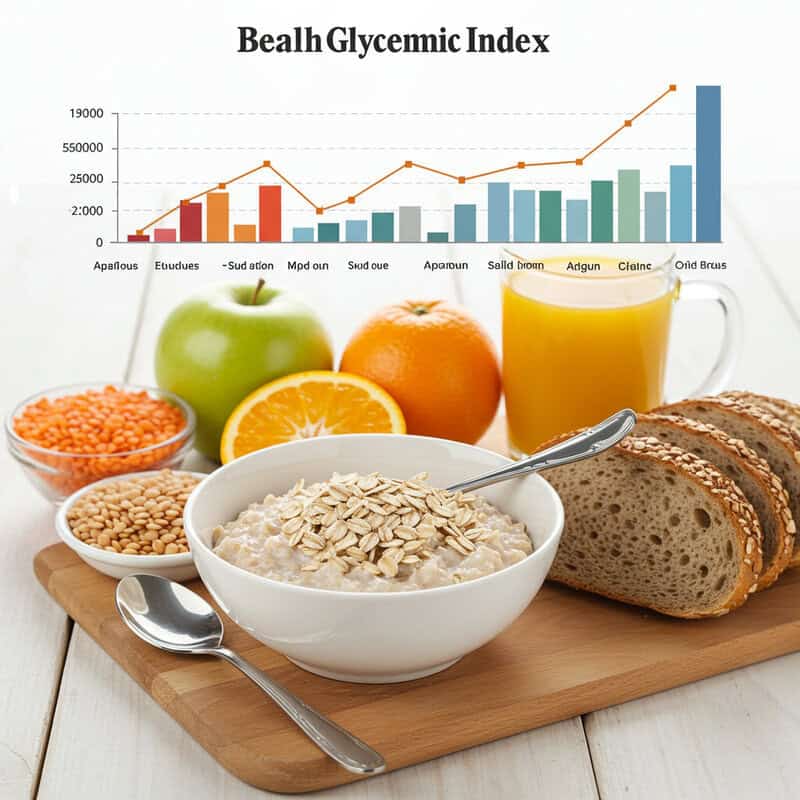
The glycemic index (GI) is a system that ranks carbohydrate-containing foods by how quickly they raise blood glucose levels. Foods with a low GI (55 or less) are digested and absorbed more slowly, resulting in a gradual rise in blood sugar, while high-GI foods (70 or above) cause rapid spikes. Consistently choosing low-GI options at breakfast can lead to better glucose stability, sustained energy, and reduced risk of insulin resistance (source).
For example, oatmeal made from whole rolled oats has a significantly lower GI than white bread, which is rapidly broken down and absorbed. Swapping high-GI foods for low-GI alternatives—such as replacing sugary breakfast cereals with steel-cut oats, or choosing whole-grain toast over white bread—can make a meaningful difference in glucose control. Other GI-friendly swaps include berries instead of fruit juice, Greek yogurt in place of flavored varieties, and adding nuts or seeds to slow carbohydrate absorption. You can find more about GI values and food choices at the University of Sydney’s Glycemic Index database. Prioritizing low-GI foods is a simple yet powerful way to enhance your morning routine for optimal glucose management.
16. Staying Mindful of Fruit Juices

Fruit juices, often perceived as a healthy morning option, can contain surprisingly high amounts of natural sugars with little fiber to offset their glycemic impact. A single 8-ounce glass of orange juice, for example, contains about 23 grams of sugar—comparable to many soft drinks. Without the fiber found in whole fruit, juice is rapidly digested, leading to quick spikes in blood glucose (source). This can be particularly problematic for those with insulin resistance, prediabetes, or diabetes, as it may contribute to greater glucose variability and energy crashes.
Comparative studies highlight that eating whole fruit leads to lower and more sustained increases in blood sugar compared to drinking juice, thanks to fiber’s ability to slow carbohydrate absorption (source). If you enjoy fruit in the morning, opt for fresh, whole options such as apples, berries, or oranges, which provide both nutrients and fiber. If you do choose juice, limit portion sizes to 4 ounces or less, and consider diluting it with water to reduce sugar intake. Always check labels for added sugars, and remember that moderation and mindful choices are key for glucose-friendly mornings.
17. Including Healthy Fats

Incorporating healthy fats into your morning meal can help moderate blood sugar by slowing the digestion and absorption of carbohydrates. Fats act as a buffer, reducing the rate at which glucose enters the bloodstream, leading to steadier post-meal glucose levels. A study published in Nutrients highlights that meals containing unsaturated fats, such as those from avocados, nuts, or seeds, are associated with improved glycemic response and increased satiety.
Avocado toast is a popular and practical breakfast example. When spread on whole-grain bread, avocado supplies monounsaturated fats along with fiber, further enhancing glucose stability. Nut butters like almond or peanut butter, when added to oatmeal or paired with fruit, provide a satisfying dose of healthy fats and protein. Seeds such as chia, flax, or sunflower can be sprinkled on yogurt or blended into smoothies for an extra nutritional boost. The Harvard School of Public Health recommends prioritizing unsaturated fats over saturated or trans fats for cardiovascular and metabolic health. By mindfully adding healthy fats to your breakfast, you lay the foundation for balanced energy and improved glucose control throughout the day.
18. Avoiding Artificial Sweeteners Early
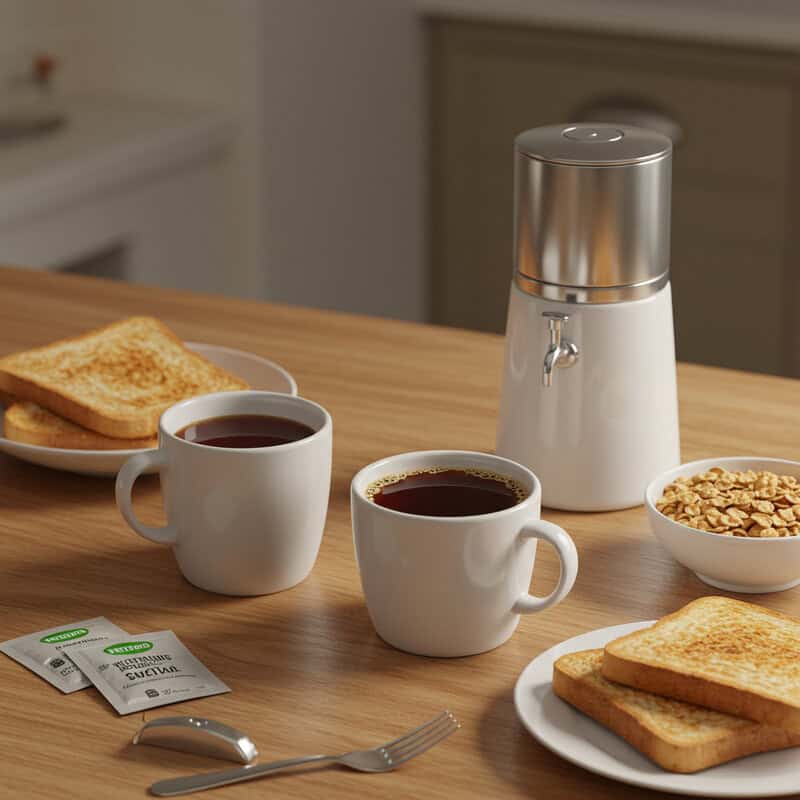
The use of artificial sweeteners in the morning—such as in coffee, tea, or breakfast foods—has become increasingly common, but research on their impact on glucose metabolism is mixed. Some studies suggest that certain non-nutritive sweeteners, including aspartame and sucralose, may disrupt gut microbiota and influence glucose tolerance, even though they do not directly raise blood sugar (source). Other research indicates that regular consumption of artificial sweeteners may alter cravings and appetite regulation, potentially leading to increased calorie intake later in the day.
For example, adding sweeteners to your morning coffee or choosing diet beverages at breakfast might seem like a harmless way to reduce sugar intake, but it may not always support optimal metabolic health. According to the Harvard T.H. Chan School of Public Health, moderation and variety are key, and individuals with concerns about glucose management should be especially cautious. If you desire sweetness in the morning, consider natural options like cinnamon or small amounts of fruit. Being mindful about artificial sweetener use, especially at the start of your day, can help you better understand your body’s response and make more informed choices for glucose stability.
19. Not Rushing Your Meal

How quickly you eat your breakfast can have a direct impact on your blood glucose response. Eating too rapidly has been linked to higher postprandial (after-meal) glucose spikes and reduced satiety, as the body has less time to register fullness and properly regulate digestive hormones. A study in the International Journal of Behavioral Nutrition and Physical Activity found that slower eating speeds were associated with lower blood sugar and insulin levels compared to eating quickly, even when consuming the same foods.
Mindful eating, which involves paying attention to each bite, chewing thoroughly, and minimizing distractions, can help improve digestion and metabolic outcomes. In contrast, distracted eating—such as consuming breakfast while scrolling on your phone or rushing to get out the door—often leads to overeating and more pronounced glucose fluctuations. To slow down, try setting aside 10-15 minutes to focus solely on your meal, putting down utensils between bites, or practicing gratitude before eating. According to the Harvard T.H. Chan School of Public Health, making your morning meal a mindful ritual can help support steadier energy and more balanced glucose levels throughout the day.
20. Limiting Morning Alcohol Intake

Alcohol consumption in the morning, whether at brunch or special occasions, can have significant effects on blood glucose regulation. Alcohol impairs the liver’s ability to release glucose into the bloodstream, which can lead to hypoglycemia—particularly if consumed on an empty stomach or in individuals taking glucose-lowering medications. According to the Centers for Disease Control and Prevention (CDC), even moderate amounts of alcohol can disrupt normal glucose homeostasis and may produce unpredictable blood sugar swings.
Popular brunch cocktails like mimosas, Bloody Marys, or spiked coffees not only introduce alcohol but often contain added sugars, further complicating glucose management. Research, including findings from the National Institutes of Health, suggests that the metabolic effects of alcohol are greatest when consumed in the morning, as the body’s ability to metabolize alcohol efficiently is reduced after overnight fasting. For optimal glucose stability and overall health, it is recommended to abstain from morning alcohol. Choose non-alcoholic beverages such as herbal teas, black coffee, or infused water to start your day, supporting both liver function and balanced blood sugar levels.
21. Checking Labels on Packaged Foods

Many breakfast staples—such as granola bars, flavored yogurts, and instant oatmeal—contain hidden sugars and refined carbohydrates that can quickly elevate morning blood glucose. These added sugars often appear under various names, including sucrose, high-fructose corn syrup, and maltodextrin, making it easy to underestimate your intake. For example, some granola bars advertised as “healthy” may contain as much sugar as a candy bar, undermining your efforts to stabilize blood sugar (source).
Comparing products by simply glancing at the front label can be misleading. It’s important to read the Nutrition Facts panel and ingredient list to identify the true sugar content and look for fiber, protein, and healthy fats that can help blunt glucose spikes. The U.S. Food & Drug Administration (FDA) offers guidance on interpreting these labels and choosing products with less added sugar and more nutritional value. Whenever possible, opt for whole, minimally processed foods for breakfast. If you rely on packaged foods, prioritize those with minimal added sugars and a balance of macronutrients to support a more stable start to your day.
22. Limiting Processed Carbohydrates

Processed carbohydrates, such as white bread, pastries, and many breakfast cereals, are rapidly digested and absorbed, leading to quick and pronounced spikes in blood glucose. These foods are typically stripped of fiber and essential nutrients during processing, which removes the natural components that slow carbohydrate absorption and help moderate the body’s glycemic response (source). Consuming refined carbs regularly in the morning can contribute to insulin resistance, increased appetite, and energy crashes later in the day.
Whole grain options, on the other hand, retain their fiber, vitamins, and minerals, resulting in a slower and more controlled release of glucose into the bloodstream. For example, swapping white bread for whole grain or sprouted grain toast, and choosing steel-cut oats instead of instant oatmeal, can help maintain more stable morning glucose levels. Additional alternatives include quinoa porridge, brown rice cakes, or baked sweet potatoes. The Centers for Disease Control and Prevention (CDC) recommends prioritizing whole, minimally processed carbohydrates as part of a balanced breakfast. These choices not only support glucose control but also provide lasting energy and vital nutrients for overall health.
23. Not Delaying Your First Meal Too Long

Delaying your first meal for too long after waking can inadvertently raise morning blood glucose due to the body’s natural hormonal rhythms. Prolonged fasting increases cortisol production, which stimulates the liver to release stored glucose into the bloodstream, potentially resulting in higher fasting glucose levels (source). This effect is particularly noticeable in individuals with diabetes or impaired glucose tolerance, where the body’s ability to regulate these hormonal surges is already compromised.
Studies indicate that those who eat breakfast earlier in the morning tend to have better insulin sensitivity and more stable glucose profiles throughout the day compared to those who delay their first meal (source). Early breakfast eaters also report improved energy and reduced cravings. To support optimal glucose control, aim to eat within one to two hours of waking. If your mornings are hectic, consider prepping a simple, balanced meal the night before, such as overnight oats or a hard-boiled egg with fruit. Sticking to a regular breakfast schedule helps synchronize your body’s metabolic clock, paving the way for steadier blood sugar and sustained energy all morning long.
24. Including Dietary Fiber
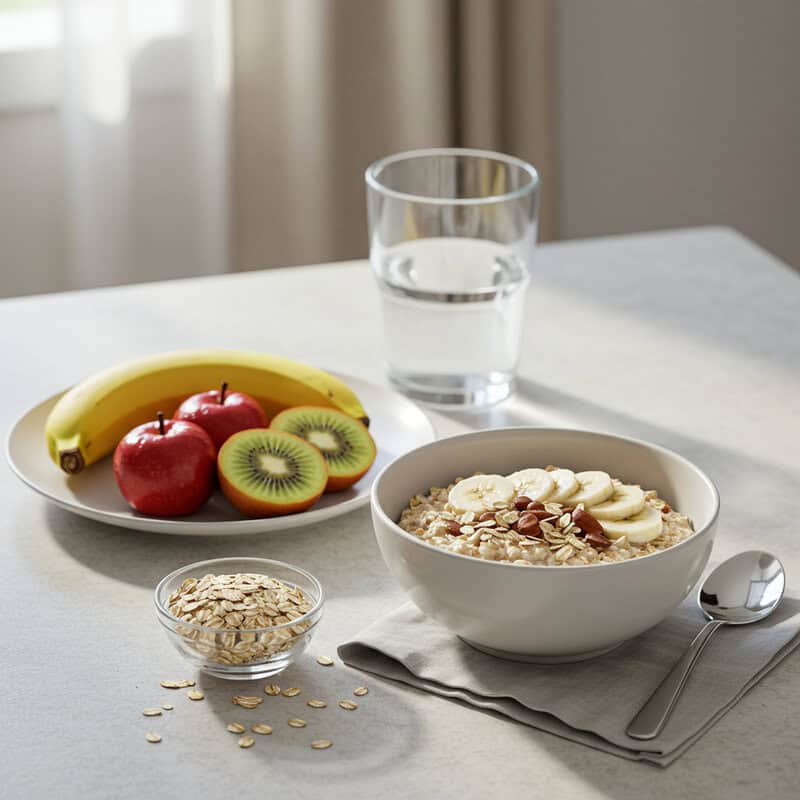
Dietary fiber is an essential component of a glucose-friendly morning routine, as it slows the absorption of carbohydrates and helps prevent rapid spikes in blood sugar after meals. Soluble fiber, in particular, forms a gel-like substance in the digestive tract, which delays gastric emptying and moderates the release of glucose into the bloodstream (source). Regular consumption of fiber has been linked to improved insulin sensitivity and lower risk of developing type 2 diabetes.
Incorporating fiber-rich foods into your breakfast is both simple and beneficial. Examples include adding berries, such as raspberries or blackberries, to your oatmeal or yogurt. Whole grain oats themselves are an excellent source of soluble fiber and can be paired with seeds like chia or flax for an extra boost. Other high-fiber options include whole grain toast, legumes, apples with skin, and vegetables like spinach or kale blended into smoothies. The Harvard T.H. Chan School of Public Health recommends aiming for at least 25-30 grams of fiber per day from a variety of sources. Prioritizing fiber each morning not only supports healthy blood glucose but also promotes digestive and cardiovascular health.
25. Preparing Breakfast the Night Before
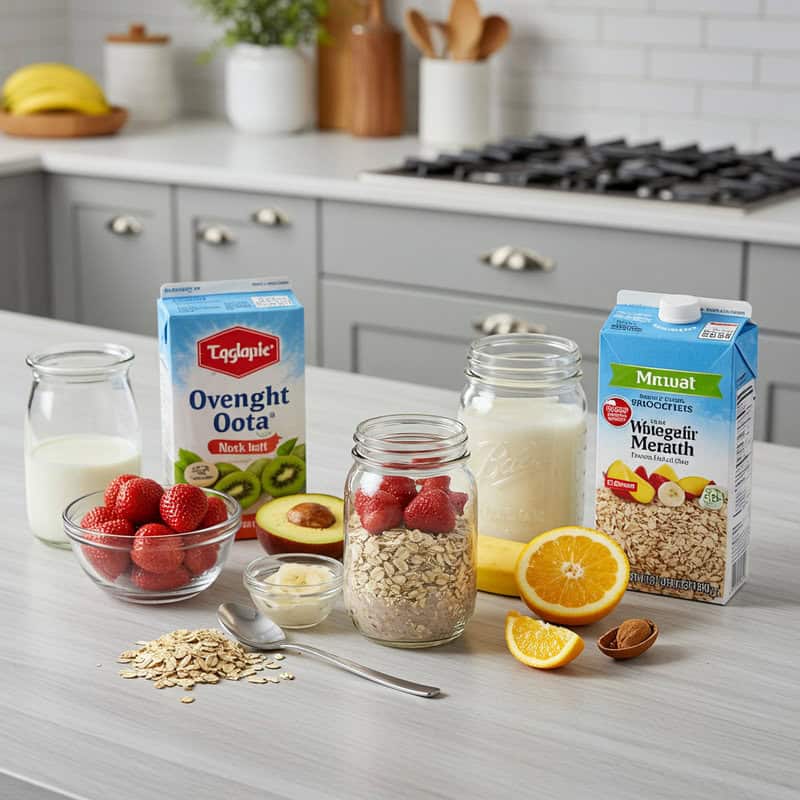
Preparing breakfast in advance is a practical strategy to reduce morning stress and avoid rushed, less nutritious food choices. When mornings are hectic, it’s easy to reach for sugary pastries or processed snacks that can spike blood glucose. Meal prepping the night before ensures you have a balanced, glucose-friendly option ready to go, supporting steadier energy and better metabolic health (source).
Overnight oats are a popular and simple example of an advance-prepped breakfast. By combining rolled oats, milk or yogurt, chia seeds, and fruit in a jar and letting it sit overnight, you create a fiber- and protein-rich meal that’s ready by morning. Other ideas include prepping hard-boiled eggs, portioning out smoothie ingredients, or assembling vegetable frittatas in advance. Planning ahead allows you to control ingredients, balance macronutrients, and reduce reliance on processed foods. The Harvard T.H. Chan School of Public Health recommends meal prepping as a way to foster healthier eating patterns. By investing a few minutes the night before, you set yourself up for a calm, nourishing start that supports stable glucose levels.
26. Limiting Added Sugars in Coffee or Tea

Adding sugar to your morning coffee or tea may seem harmless, but these sweetened beverages can contribute substantially to your daily sugar intake and lead to rapid spikes in blood glucose. Even a single tablespoon of sugar contains about 12 grams of carbohydrates, which can quickly accumulate if you enjoy multiple cups each morning. According to the Centers for Disease Control and Prevention (CDC), beverages are a major source of added sugars in the American diet, often consumed without much thought.
Black coffee and unsweetened tea are virtually calorie- and sugar-free, making them better choices for steady glucose control. In contrast, sweetened versions—such as flavored lattes, chai teas, or prepackaged coffee drinks—can contain multiple teaspoons of added sugar and hidden syrups (source). To reduce sugar intake, consider gradually cutting back by using less sweetener each week, switching to spices like cinnamon, or adding a splash of milk or non-dairy alternatives for flavor. Over time, your taste buds adjust, and you may come to prefer the natural flavors of coffee and tea, supporting a healthier and more glucose-friendly morning routine.
27. Using Cinnamon or Spices for Flavor

Cinnamon and other natural spices do more than just enhance the taste of your breakfast—they may also offer metabolic benefits, especially for blood glucose regulation. Several studies have explored cinnamon’s potential to lower fasting blood sugar and improve insulin sensitivity, with promising results in certain populations. For example, a meta-analysis published in the journal Annals of Family Medicine found that cinnamon supplementation was associated with modest reductions in fasting blood glucose among people with type 2 diabetes.
Incorporating cinnamon into breakfast is easy and versatile. Sprinkle it over oatmeal, add it to Greek yogurt, or stir it into smoothies for a naturally sweet flavor without added sugar. Other spices, such as nutmeg, ginger, or cardamom, can also provide warmth and complexity to morning meals while offering their own antioxidant and anti-inflammatory properties. The Harvard T.H. Chan School of Public Health encourages the use of spices as a healthy way to boost flavor and nutrition. By reaching for cinnamon and other spices, you can reduce your reliance on sweeteners and support a glucose-friendly, flavorful start to your day.
28. Avoiding Energy Drinks

Energy drinks are marketed as a quick fix for morning fatigue, but their high sugar and caffeine content can be detrimental to glucose control and overall health. Many energy drinks contain upwards of 25-30 grams of sugar per can, delivering a rapid glucose spike followed by an inevitable crash. High doses of caffeine—often exceeding the amount in a strong cup of coffee—can also temporarily reduce insulin sensitivity and may trigger jitteriness, anxiety, and even cardiac symptoms in sensitive individuals (source).
Case studies and reports have linked regular energy drink consumption to increased risk of hyperglycemia, especially in people with underlying metabolic or cardiovascular issues. According to the Centers for Disease Control and Prevention (CDC), energy drinks are not recommended for children, adolescents, or anyone with concerns about blood sugar management. Instead of reaching for these products, opt for healthier alternatives like water, unsweetened herbal tea, or black coffee in moderation. If you need an energy boost, consider pairing your beverage with a balanced breakfast, light exercise, and exposure to natural light—habits that support both alertness and stable glucose throughout the morning.
29. Practicing Gratitude or Positive Thinking

The relationship between stress and glucose control is well-established: elevated stress levels, especially in the morning, can trigger the release of cortisol and other hormones that increase blood sugar. In contrast, beginning your day with gratitude or positive thinking may help buffer these stress responses and support healthier glucose regulation. Research has shown that gratitude practices—such as journaling or reflecting on positive experiences—can lower perceived stress, reduce inflammatory markers, and even improve glycemic control in people with diabetes (source).
Gratitude journaling, even for just a few minutes each morning, creates a sense of calm and focus, setting a positive tone for the day. This mindset shift can counteract the hurried, anxious feelings that often accompany rushed mornings and disrupt healthy routines. Simple practices might include writing down three things you’re thankful for, reflecting on small wins, or repeating positive affirmations. According to the Harvard Medical School, cultivating gratitude is linked not only to emotional well-being but also to physical health benefits. By integrating gratitude or positive thinking into your morning routine, you can foster resilience, lower stress, and create a more glucose-friendly environment for your body.
30. Taking a Short Walk Post-Breakfast

Engaging in light physical activity after breakfast is a powerful, evidence-based strategy for improving glucose control. When you move your muscles, they use glucose from the bloodstream for energy, which helps to blunt the typical post-meal blood sugar rise. Numerous studies have demonstrated that even a brief, low-intensity walk after eating can significantly reduce postprandial glucose levels. For example, research published in Diabetes Care found that a 10-minute walk after each meal led to better blood sugar control in individuals with type 2 diabetes than a single 30-minute walk at another time of day.
Post-breakfast walks are especially helpful because mornings can be a period of heightened insulin resistance due to natural hormonal changes. Just 10 minutes of walking—whether in your neighborhood, around your home, or even marching in place—can make a measurable difference in glucose management (source). This practice also supports digestion, energy, and mental clarity. To establish the habit, consider pairing your walk with another part of your routine, such as listening to a favorite podcast or calling a friend. Consistent, gentle movement after breakfast is an accessible way to support stable blood sugar and overall well-being.
31. Avoiding Early-Morning Intense Workouts

While regular exercise is essential for metabolic health, engaging in high-intensity workouts immediately after waking can temporarily raise blood glucose levels due to the body’s stress response. Vigorous activity triggers the release of stress hormones like cortisol and adrenaline, which prompt the liver to release stored glucose into the bloodstream for rapid energy (source). For individuals with insulin resistance or diabetes, this can result in a marked spike in morning blood sugar, potentially offsetting the longer-term benefits of exercise.
In contrast, gentle movement—such as stretching, yoga, or a brisk walk—elicits a milder hormonal response and supports gradual glucose uptake by muscles without excessive spikes. Research from the American Diabetes Association suggests that light to moderate exercise in the morning is generally safer for glucose management, especially before breakfast. If you prefer high-intensity training, try scheduling it for later in the day when your body’s hormonal environment is more stable. Moderation, self-awareness, and regular glucose monitoring can help you personalize your routine for optimal results, balancing the benefits of exercise with the need for stable morning blood sugar.
32. Limiting Screen Time Upon Waking

Immediately reaching for your phone, tablet, or computer upon waking can have a surprising impact on your hormonal balance and glucose regulation. The blue light emitted from screens can suppress melatonin, a hormone involved in sleep-wake cycles, and disrupt the natural morning surge of cortisol that helps regulate glucose metabolism (source). Additionally, exposure to stressful news or social media notifications first thing in the morning can trigger anxiety and increase cortisol levels, both of which are linked to higher blood sugar.
In contrast, device-free mornings allow your body and mind to gently adjust to the day, supporting a more stable hormonal environment. Research indicates that starting the day without screens can promote mindfulness, lower stress, and improve mood (source). To minimize screen exposure, try alternatives such as stretching, meditating, journaling, or enjoying a quiet breakfast. Consider placing your phone out of reach and waiting at least 30 minutes before checking messages or emails. Cultivating a screen-free morning routine can help you protect your circadian rhythm, reduce stress, and support steadier glucose levels as you begin your day.
33. Avoiding Overeating at Breakfast

Portion control is a crucial factor in maintaining stable blood glucose levels, especially at breakfast when your body is transitioning from an overnight fast. Overeating, even with healthy foods, can lead to excessive carbohydrate intake, resulting in higher and more prolonged glucose spikes as your digestive system processes the surplus energy. Research published in Nutrients emphasizes that moderate-sized meals are associated with improved postprandial glucose and insulin responses compared to larger, calorie-dense breakfasts.
A moderate breakfast, balanced in protein, healthy fats, and complex carbohydrates, helps sustain energy and prevents overwhelming your body’s insulin response. In contrast, oversized portions—such as large stacks of pancakes or multiple servings of cereal—can create significant glucose variability and contribute to feelings of sluggishness. To practice mindful portion control, use smaller plates or bowls, pre-portion items like yogurt or granola, and take time to assess your hunger and fullness cues. The Centers for Disease Control and Prevention (CDC) recommends visual cues and mindful eating strategies to avoid overeating. By serving yourself moderate, intentional portions, you support more predictable blood sugar and set a healthy tone for the rest of the day.
34. Managing Morning Anxiety

Morning anxiety can have a pronounced impact on blood glucose regulation due to the physiological effects of stress hormones such as cortisol and adrenaline. When anxiety levels are high upon waking, these hormones stimulate the liver to release stored glucose, which can cause elevated blood sugar even before breakfast (source). Common stress triggers in the morning include looming work deadlines, negative news, family responsibilities, or even anticipatory worry about the day ahead.
Unchecked, this anxiety-driven hormonal surge can lead to glucose instability, energy crashes, and impaired focus. To counteract these effects, it’s helpful to cultivate calming techniques as part of your morning routine. Practices such as deep breathing exercises, progressive muscle relaxation, short meditation sessions, or gentle stretching can lower cortisol levels and encourage a state of calm. Even a few minutes spent journaling or practicing gratitude can reframe your mindset and buffer the physiological impact of stress (source). Identifying your personal triggers and proactively managing anxiety allows you to start the day with steadier nerves—and more stable glucose levels—supporting both your emotional and metabolic well-being.
35. Choosing Whole Fruits Over Juices

Opting for whole fruits instead of fruit juices at breakfast can make a significant difference in glucose regulation. Whole fruits contain natural fiber, which slows the absorption of sugars and prevents rapid spikes in blood glucose. In contrast, fruit juices—even those labeled “100% juice”—lack this fiber and deliver a concentrated dose of sugar that is quickly absorbed by the body. For example, a medium apple contains about 4 grams of fiber and 19 grams of sugar, while an 8-ounce glass of apple juice contains little to no fiber and approximately 24 grams of sugar (source).
This means that eating a whole apple will lead to a slower, more stable glucose rise compared to drinking apple juice, which can cause a sharp spike and subsequent crash. The Harvard T.H. Chan School of Public Health recommends choosing whole fruits over juices for optimal metabolic health. Enjoying oranges, berries, pears, or apples in their whole form not only provides beneficial fiber but also delivers a range of vitamins, minerals, and antioxidants. Prioritizing whole fruits at breakfast supports better glucose control and long-term wellness.
36. Not Relying on Breakfast Bars

Many breakfast bars marketed as “healthy” or “energy-boosting” can contain hidden sugars, refined carbohydrates, and low-quality fats that undermine stable glucose control. Packaged bars frequently list sugar or syrups as one of the main ingredients, and some varieties contain as much sugar as a candy bar—sometimes exceeding 15 grams per serving (source). These quick-digesting carbs can lead to rapid blood sugar spikes and crashes, leaving you feeling hungry and fatigued shortly after eating.
Homemade breakfast bars or bites, on the other hand, allow you to control the ingredients and avoid unnecessary sugars and additives. By using whole grains, nuts, seeds, and natural sweeteners in moderation, you can create a more balanced, nutrient-dense option. If you do choose packaged bars, the FDA recommends checking the Nutrition Facts panel for fiber, protein, and added sugar content, and reviewing the ingredient list for whole-food sources. Whenever possible, prioritize whole, minimally processed foods for breakfast to support more stable glucose and longer-lasting energy throughout the morning.
37. Practicing Slow, Deep Breathing

Slow, deep breathing exercises have been shown to reduce cortisol levels and help regulate blood glucose by activating the body’s relaxation response. When practiced in the morning, these exercises can counteract the natural cortisol surge that occurs upon waking, as well as any additional anxiety or stress that may elevate blood sugar. Studies, such as those reviewed in Frontiers in Psychology, confirm that slow, diaphragmatic breathing can lower heart rate, decrease stress hormone secretion, and support greater metabolic stability.
Incorporating breathing routines into your morning ritual is simple and does not require any equipment. Common techniques include box breathing (inhale for four counts, hold for four, exhale for four, hold for four), 4-7-8 breathing (inhale for four, hold for seven, exhale for eight), or simply focusing on slow, deep inhalations and exhalations for several minutes. Even dedicating three to five minutes to mindful breathing can create a sense of calm and set a positive tone for the day. The Harvard Medical School notes that regular practice of deep breathing techniques can be a powerful tool for lowering stress-induced glucose fluctuations and improving overall well-being.
38. Avoiding High-Sodium Processed Meats

Processed meats such as bacon, sausage, and ham are common breakfast staples, but they are often high in sodium, saturated fats, and preservatives—factors linked to increased insulin resistance and a higher risk of type 2 diabetes. Research published in Current Diabetes Reports highlights that regular consumption of processed meats is associated with impaired glucose metabolism and chronic inflammation, both of which undermine metabolic health.
In contrast, plant-based protein sources like tofu, tempeh, beans, or nuts provide essential amino acids without the added sodium and unhealthy fats. These alternatives are also rich in fiber, antioxidants, and phytonutrients that support stable blood sugar and cardiovascular wellness. For a more glucose-friendly breakfast, consider swapping bacon for a serving of black beans, avocado toast with seeds, or a tofu scramble with vegetables. The Harvard T.H. Chan School of Public Health recommends limiting processed meats and choosing plant proteins or lean, minimally processed meats for better long-term outcomes. Making these swaps can help reduce your sodium intake, improve insulin sensitivity, and support a healthier morning routine.
39. Keeping a Morning Glucose Log
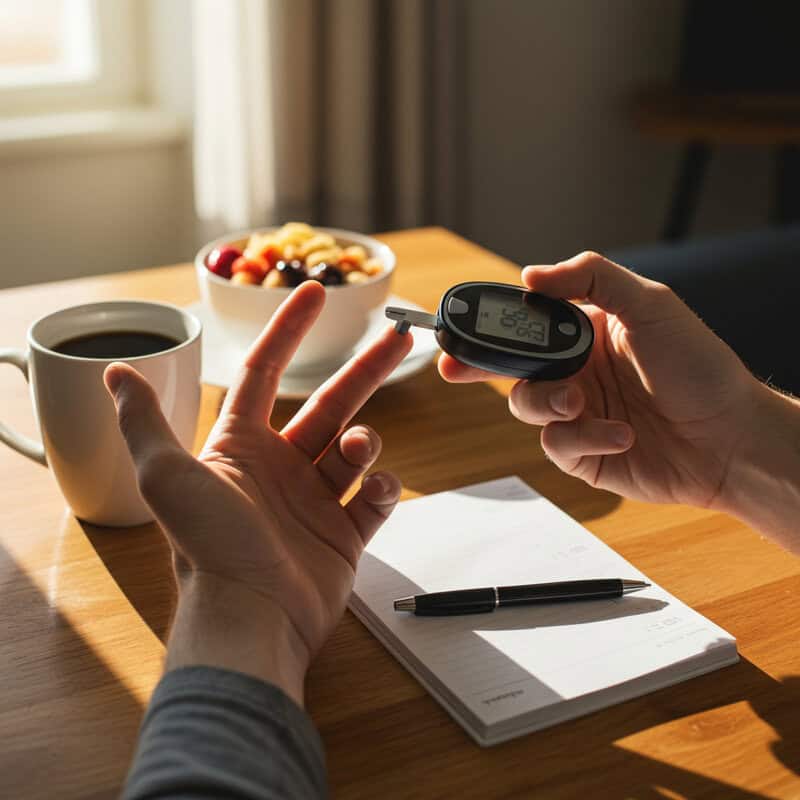
Tracking your morning blood glucose levels can be a powerful tool for managing and optimizing your metabolic health. Recording these values over time allows you to identify patterns, spot trends, and connect fluctuations to specific lifestyle habits, such as meal choices, stress, sleep quality, or medication timing. According to the Centers for Disease Control and Prevention (CDC), maintaining a glucose log helps individuals and healthcare providers make informed adjustments to diet, activity, and treatment plans.
For example, you may notice that skipping breakfast, consuming a high-sugar meal, or experiencing a stressful morning correlates with higher glucose readings. Conversely, gentle exercise, balanced meals, and stress management techniques might be associated with more stable numbers. Journals, spreadsheets, or dedicated apps—such as mySugr, Glucose Buddy, or the Diabetes Food Hub app—make tracking easy and convenient. Include additional notes about sleep, mood, or physical activity for context. Reviewing your log regularly helps you and your healthcare team refine your morning routine for better glucose control, empowering you to take charge of your health and make proactive, data-driven choices.
40. Washing Hands Before Testing Glucose

Proper handwashing before checking your blood glucose is a simple yet critical step for obtaining accurate readings. Residues from food, lotions, or other substances on your fingertips can contaminate the blood sample and skew results, sometimes leading to falsely high or low glucose values. For instance, if you’ve recently handled fruit, sugar, or even certain cleaning products, trace amounts left on the skin can transfer to the test strip and result in misleading readings (source).
There have been documented cases where individuals received alarmingly high glucose readings due to residual sugar on their fingers—prompting unnecessary concern or inappropriate medication adjustments. The American Diabetes Association recommends thoroughly washing your hands with soap and warm water, then drying them completely before testing. Avoid using hand sanitizers or wipes, as they may contain glycerin or alcohol, which can also affect readings. By making handwashing a standard part of your morning glucose check, you help ensure reliable results, better trend tracking, and more informed decisions for your daily glucose management.
41. Avoiding High-Carb Smoothies

While smoothies are often marketed as a healthy breakfast option, many commercially available or homemade smoothies can be high in sugar and rapidly digestible carbohydrates. Smoothies made primarily with fruit juice, bananas, mangoes, and sweetened yogurts can contain 30 grams of sugar or more per serving, causing quick and pronounced spikes in blood glucose (source). These high-carb blends, though nutrient-rich, lack the balance needed to moderate the body’s glycemic response in the morning.
Balanced smoothie recipes, on the other hand, combine moderate portions of lower-sugar fruits like berries with protein sources—such as Greek yogurt, unsweetened protein powder, or nut butter—and add fiber-rich greens like spinach or kale. This combination slows carbohydrate absorption, supports satiety, and helps stabilize blood glucose. The Harvard T.H. Chan School of Public Health suggests prioritizing whole ingredients and limiting sweeteners to keep your smoothie glucose-friendly. Experiment by adding chia seeds, flaxseed, or avocado to further boost fiber and healthy fats. By intentionally crafting your morning smoothie, you can enjoy both convenience and stable energy—without the sugar rush.
42. Checking Symptoms of Morning Hyperglycemia

Morning hyperglycemia, or elevated blood glucose upon waking, can present with a range of noticeable symptoms. Common signs include excessive thirst, frequent urination, fatigue, blurred vision, headaches, and dry mouth (source). Some individuals may also experience irritability or difficulty concentrating. Recognizing these symptoms early is crucial, as persistent high glucose levels can lead to long-term complications and may require adjustments to your morning routine or treatment plan.
Real-world cases highlight the importance of being vigilant. For example, one person might attribute their morning fatigue to poor sleep when, in fact, undiagnosed hyperglycemia is the underlying cause. Another may notice increased thirst and frequent urination following a high-carb breakfast, signaling a glucose spike. If you notice any of these symptoms—especially if they occur regularly—it’s important to check your fasting blood glucose with a reliable meter or continuous glucose monitor. The American Diabetes Association recommends contacting your healthcare provider for persistent or unexplained high readings. Timely recognition and intervention can help you take control of your morning glucose and prevent more serious health issues.
43. Not Skipping Medically Necessary Carbohydrates

While managing carbohydrate intake is crucial for stable glucose levels, there are specific situations where consuming carbohydrates in the morning is medically necessary. For individuals taking certain glucose-lowering medications, such as insulin or sulfonylureas, eating carbohydrates helps prevent hypoglycemia (dangerously low blood sugar) after medication administration. Clinical scenarios include people with type 1 diabetes, those on intensive insulin therapy, or individuals prescribed medications that increase insulin production regardless of food intake (source).
Skipping breakfast or eliminating carbohydrates completely in these cases can result in symptoms like shakiness, dizziness, confusion, or even loss of consciousness. For example, a person who injects insulin and skips their morning meal is at significant risk for early-morning hypoglycemia. The American Diabetes Association emphasizes the importance of pairing medication timing with appropriate food intake. If you are unsure about your carbohydrate needs, especially when adjusting your diet or medication regimen, consult your healthcare provider or a registered dietitian. They can help you determine the right balance for your morning routine to maintain safe and stable blood glucose levels.
44. Limiting Morning Dairy if Sensitive

Lactose, the natural sugar found in milk and many dairy products, can impact blood glucose response differently depending on individual tolerance. For those who are lactose intolerant or sensitive, consuming dairy in the morning may lead not only to digestive discomfort—such as bloating, cramping, or diarrhea—but also to erratic glucose absorption due to gastrointestinal distress (source). This can make it challenging to accurately predict blood sugar responses after a dairy-rich breakfast.
Dairy-tolerant individuals generally experience a moderate and sustained glucose release from lactose-containing foods like milk, yogurt, or cheese. However, those with sensitivities may have inconsistent glucose patterns and unpleasant symptoms. If you suspect dairy is affecting your morning glucose or overall well-being, consider non-dairy alternatives such as unsweetened almond, soy, or oat milk, and plant-based yogurts. The Harvard T.H. Chan School of Public Health recommends choosing fortified, low-sugar dairy substitutes when needed. Always read ingredient lists and nutrition labels, as some non-dairy alternatives contain added sugars or less protein. If you’re unsure about your tolerance or how dairy affects your glucose, consult your healthcare provider or a registered dietitian for personalized guidance.
45. Avoiding Skipping Hydration After Exercise

Hydrating after morning exercise is essential for maintaining stable blood glucose. Physical activity causes fluid loss through sweat and increased respiration, and failing to replenish these fluids can lead to mild dehydration. Dehydration, even at low levels, has been shown to raise blood glucose by reducing plasma volume and impairing the body’s ability to utilize insulin effectively (source).
For example, individuals who complete a brisk morning walk, run, or gym session and then delay drinking water may notice higher post-exercise glucose readings and feel sluggish or lightheaded. The Centers for Disease Control and Prevention (CDC) recommends drinking water as your primary post-workout beverage. Aim for at least 16-24 ounces (500-700 ml) of water within an hour after exercise, adjusting based on intensity, sweat loss, and climate. Including a pinch of salt or an electrolyte drink may be helpful for longer or more strenuous sessions. Staying on top of your hydration routine after exercise not only supports glucose regulation, but also promotes efficient recovery, mental clarity, and overall well-being throughout the morning.
46. Watching for Dawn Phenomenon
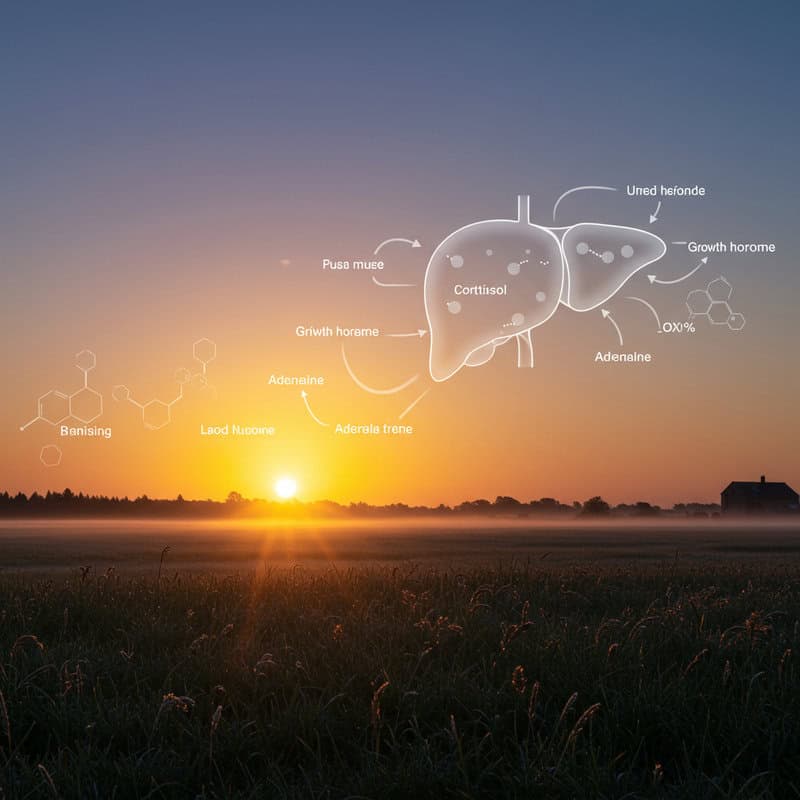
The dawn phenomenon refers to a natural rise in blood glucose that occurs in the early morning hours, typically between 2 a.m. and 8 a.m., due to a surge in hormones such as cortisol, growth hormone, and adrenaline. These hormones stimulate the liver to release stored glucose into the bloodstream, preparing the body for the day ahead (source). For people with diabetes or impaired glucose tolerance, this physiological response can result in noticeable morning hyperglycemia, even before any food is consumed.
Real-world patterns of the dawn phenomenon may include consistently elevated fasting glucose readings, despite adherence to medication and dietary routines. Some individuals observe a steady increase in glucose during the early morning hours on continuous glucose monitoring devices, while others experience symptoms such as fatigue, thirst, or irritability upon waking. The American Diabetes Association recommends monitoring fasting glucose trends over several days and discussing persistent morning elevations with your healthcare provider. Adjustments to medication timing, evening snacks, or physical activity may help mitigate the dawn phenomenon. Awareness and proactive management are key to maintaining optimal morning glucose control.
47. Being Cautious with Intermittent Fasting

Intermittent fasting (IF) has gained popularity as a dietary strategy, but its effects on morning glucose levels can vary widely depending on the individual and the chosen fasting window. Restricting food intake to a certain time frame—such as 16:8 or 14:10—may improve insulin sensitivity for some, but for others, especially those with diabetes or on glucose-lowering medications, it can lead to hypoglycemia or unpredictable blood sugar fluctuations (source). Extended fasting may increase cortisol and trigger the liver to release glucose, sometimes resulting in elevated fasting glucose or the dawn phenomenon.
Comparing approaches, some people find that breaking their fast earlier in the morning supports steadier glucose control, while others tolerate a later first meal without issue. Factors such as age, activity level, medication use, and underlying metabolic health all influence the safety and effectiveness of IF. The American Diabetes Association advises that anyone considering intermittent fasting—especially those with diabetes or on medication—should consult a healthcare provider before starting. Personalized guidance ensures that fasting supports, rather than disrupts, your morning glucose management and overall well-being.
48. Setting a Morning Routine Checklist

Creating a morning routine checklist can be a powerful tool for building and maintaining healthy habits that support stable glucose levels. A checklist provides structure, reduces decision fatigue, and serves as a visual reminder to prioritize key behaviors—such as hydration, balanced eating, stress management, and timely medication. Research in habit formation suggests that written or digital checklists significantly increase adherence to routines and make it easier to track progress over time (source).
Some individuals prefer traditional paper checklists, which can be placed on the refrigerator, bathroom mirror, or bedside table for easy reference. Others utilize digital tools—like smartphone apps, calendar reminders, or habit-tracking platforms—to automate prompts and record completion. Both approaches offer unique benefits and can be tailored to fit your lifestyle. The key is to be specific; for example, your checklist might include items like “drink 16 oz water,” “check fasting glucose,” “eat protein-rich breakfast,” and “take a 10-minute walk.” According to the American Psychological Association, consistency is essential for lasting behavior change. By reviewing and following your checklist each morning, you lay the groundwork for improved metabolic health and greater daily well-being.
49. Reviewing Blood Glucose Trends Weekly

Regularly reviewing your blood glucose trends on a weekly basis allows for a more comprehensive understanding of how your morning routine and lifestyle choices impact your metabolic health over time. Trend analysis helps identify patterns—such as consistent morning highs or lows, responses to dietary changes, or the impact of stress and sleep—that may not be as apparent from daily readings alone. According to the Centers for Disease Control and Prevention (CDC), this broader perspective can provide crucial insights for proactive self-management and early intervention.
For example, a person might notice that skipping breakfast on certain days leads to higher glucose readings the following morning, or that a week of improved sleep correlates with more stable numbers. Another individual could spot a trend of gradually rising fasting glucose, signaling a need for adjustments in medication, diet, or physical activity. Utilizing apps or written logs makes weekly review easy and facilitates communication with healthcare providers. The American Diabetes Association recommends sharing your weekly trends with your care team for tailored advice and support. Regular trend analysis empowers you to make informed changes and stay on track with your glucose goals.
50. Seeking Professional Help When Needed

While a well-crafted morning routine can greatly influence glucose stability, persistent problems or unexplained trends require professional medical support. Consistently high or low fasting glucose, symptoms of hypoglycemia (such as shakiness or confusion), or ongoing morning hyperglycemia despite lifestyle changes all warrant a conversation with your healthcare provider. Early intervention is critical to prevent complications and tailor your management plan according to your unique needs (source).
Examples of situations that call for professional help include frequent episodes of dizziness, unexplained weight changes, medication side effects, or difficulty sticking to a morning routine due to physical or emotional barriers. Regular check-ups—at least annually for those at risk, and more frequently for people with diabetes—enable timely assessment of blood glucose control, medication effectiveness, and overall health. The American Diabetes Association recommends discussing any concerns, new symptoms, or significant changes in your morning readings with your care team. Ongoing collaboration with your provider ensures you receive the right guidance, resources, and interventions to protect your health and maintain optimal glucose levels in the long term.
Conclusion

Establishing a thoughtful and consistent morning routine is a powerful tool for achieving stable glucose levels and supporting overall metabolic health. Simple daily habits—from hydration and balanced meals to stress management and timely medication—can have a profound impact on blood sugar outcomes. Given the increasing prevalence of diabetes and prediabetes, adopting healthier routines is more urgent than ever (source). If you notice symptoms of impaired glucose regulation or have risk factors, consider regular screening and consult with a healthcare provider for personalized advice. Proactive engagement and individualized guidance empower you to protect your health, prevent complications, and foster lifelong well-being through your morning choices.
Disclaimer
The information provided in this article is for general informational purposes only. While we strive to keep the information up-to-date and correct, we make no representations or warranties of any kind, express or implied, about the completeness, accuracy, reliability, suitability, or availability with respect to the article or the information, products, services, or related graphics contained in the article for any purpose. Any reliance you place on such information is therefore strictly at your own risk.
In no event will we be liable for any loss or damage including without limitation, indirect or consequential loss or damage, or any loss or damage whatsoever arising from loss of data or profits arising out of, or in connection with, the use of this article.
Through this article you are able to link to other websites which are not under our control. We have no control over the nature, content, and availability of those sites. The inclusion of any links does not necessarily imply a recommendation or endorse the views expressed within them.
Every effort is made to keep the article up and running smoothly. However, we take no responsibility for, and will not be liable for, the article being temporarily unavailable due to technical issues beyond our control.




